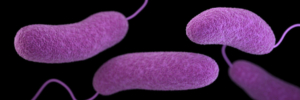A team at Johns Hopkins University led by Principle Investigator Frank Curriero investigates a bacteria that could be affecting seafood in the Chesapeake Bay. The project, funded by the National Institute of Allergy and Infectious Disease, wants to understand the underlying cause of seafood-associated illnesses leading to an estimated 80,000 illnesses in the US every year. The team wants to improve bacteria detection methods as the seafood and aquaculture industries continue to grow in the Bay.

Vibrio bacteria, courtesy of Center for Disease Control
Their team seeks to use spatial statistical methods to better predict how a bacteria called Vibrio parahaemolyticus will affect estuarine environments. They will analyze water samples taken from 148 sampling stations across the Chesapeake Bay collected from 2007 t0 2010. They found a positive association between V. parahaemolyticus abundance and temperature and turbidity, and negative associations with salinity. In their published article, they explain that “the salinity relationship was determined to be a function of both low temperature and turbidity, with an increase of either nullifying the high salinity effect.”
It is crucial that the seafood industry has better tools to predict instances of Vibrio bacteria in order to prevent human health issues from eating seafood, especially raw seafood. Studies over large areas and time scales measuring a range of factors are essential to forecast future bacteria infestations.
